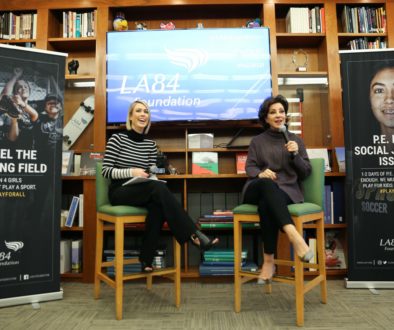SL Interview: Filmmaker Gabriela Cowperthwaite on Lacrosse in Urban Denver
The sport of lacrosse has long been stereotyped as preppy and suburban — code words for, “Lacrosse is almost exclusively white.” Indeed, while U.S. Lacrosse supports efforts to increase minority participation, through funding of the BRIDGE [Building Relationships to Initiate Diversity, Growth and Enrichment] and the First Stick programs, the sport continues to lag among minority youth.
ESPN.com recently reported that, “In 2009-10, less than 10 percent of the student-athletes playing NCAA lacrosse were black, according to the most recent NCAA Student-Athlete Race/Ethnicity Report. That statistic carries over to both men’s and women’s lacrosse in Divisions I, II and III.”
At the grassroots level, several individuals and groups have worked to improve the situation. In Denver, a fledgling hotbed of lacrosse, elementary school teacher Erik Myhren decided to bring lacrosse to the city’s public school system in 2008. With a crew of volunteer coaches and equipment donated by U.S. Lacrosse, Myhren held tryouts and fielded a team of fifth-, sixth- and seventh-graders to challenge the region’s established youth squads.
Filmmaker Gabriela Cowperthwaite, a Denver native, returned to her hometown to chronicle the first season of Myhren’s program, known as City Lax. Her documentary, also titled “City Lax,” follows the kids as they learn the basics of the game, take on Denver’s suburban powerhouses, and cope with the daily challenges of life in the inner city.
The film has made the festival circuit, winning the audience and best documentary awards at the Sonoma International Film Festival. It has aired on ESPNU and is available on Video on Demand via Sportskool.
SportsLetter spoke with Gabriela Cowperthwaite after a recent screening of the film at her alma mater, Occidental College, in Los Angeles.
— David Davis
SportsLetter: Did you play lacrosse growing up?
Gabriela Cowperthwaite: I never, ever played lacrosse. I think I maybe picked up a stick three times in my entire life. I was a soccer player.
SL: The image of lacrosse, at least on the East Coast, is suburban and preppy. Is that true in Denver as well?
GC: Without a doubt. Very preppy, very privileged, very much like the East Coast image. All the Denverites who played lacrosse were from the better-off families and the suburban schools, and they were all gunning to go back East for college. It was really big in my high school, Colorado Academy.
SL: How did you hear about the City Lax program in Denver?
GC: My best friend from college is Tor Myhren, who is a producer on the film. He is the brother of Erik Myhren, the founder and one of the coaches of the City Lax team. Tor told me about what his brother was doing with the kids and said, “I think this would be a great story for a documentary. What do you think?” I said, “Let’s do it.”
I took my own kids, who were one-and-a-half at the time, and moved both of them to Denver with me and left my poor husband here in L.A. We lived in my parents’ basement and set up our edit studio in my dad’s office. Our cinematographer moved out with us and slept in a guest bedroom. We just holed up in my parents’ house for six months.
SL: What attracted you to the story?
GC: I grew up maybe 10 blocks away from where the kids on the team live, 10 blocks away from the inner city. But I never drove in that direction. Where we lived, you went downtown or west. To go east or south – that’s entering the inner city. What’s there? A bunch of schools that we don’t go to. So, I was aware of this entire world that I had missed out on, hanging out and chilling with kids that aren’t like you. As much as I loved my education, and getting all the opportunities that I had, that was one thing that I always thought was missing. I wanted to go back and discover that in the film.
As a filmmaker, I’m a pursuer of the most human story you can possibly get. Getting someone to open up about something that’s going on with their lives, to me that’s magical. It’s documentary gold. I thought, here is an opportunity to talk to the kids and their parents about what’s really going on. We see the smiles, now let’s see what’s beneath all that.
SL: Had you done anything like this before?
GC: No, I’d never done anything like this. I’ve been in what they call the “boys and toys” part of the cable network world, doing documentaries for the History Channel, Discovery, National Geographic. It’s stories on gadgets and wars, that kind of thing. They’ve brought me amazing experiences, but they weren’t an opportunity for people to just open up and talk about what they were really thinking about their daily lives.
SL: Were there any sports films that you had in mind before you started shooting?
GC: I love the whole sports trajectory, like in “The Bad News Bears” and “The Natural.” Those movies grab you emotionally. “Hoop Dreams,” of course. And, “Friday Night Lights” in terms of music and how the musical score fits the story. I wanted music to play a big role.
We didn’t want “City Lax” to be gritty looking just because it’s based in the inner city. We’re not in Detroit. We have blue skies and green fields and mountain views in Denver, and so we went for a lyrical look. I wanted the film to be beautiful because I think the kids are beautiful.
SL: Did the story change once you starting filming?
GC: Honestly, I thought this was going to be a quick shoot. Here’s this group of kids that are totally athletic. They’re basketball players, they’re football players, they’re fast runners. I thought, give them a bunch of lacrosse sticks, they’re going to be the best. Period. They’re going to clean up. The spine of the film would be this winning season, and I’ll come in, get the interviews, shoot some “b” roll, and be out of there in six weeks. I couldn’t imagine anything else.
First game, they lose. Second game, they lose. Third game, they lose. Kids quit the team. Kids fail out of class. I did the interview with Gaghe [one of the team’s players] and found out about his mom being in prison. Needless to say, the script changed.
Any documentary that has impact – you can feel it and touch it when you’re watching it – for the director it’s like being in quicksand. You have to do another interview and another interview and then the next interview because the material is just so compelling. The story changed in my head with every game, with every interview, with every day. The sensation is like being out of control and chaotic, but knowing also that something magical is happening. It’s that combination that I felt for six months.
SL: How did you get the kids to trust you so that they would open up about their lives?
GC: The key is being there every day. By doing that you’re telling them, “I’m not going away. I’m here. I’m seeing you in your happiest moments, I’m seeing you in your worst moments, but either way I’m here.” I did a lot of stuff without a camera, where we went out to dinner and just ate popcorn shrimp and drank Cokes. There was a lot of time that I spent with them without a camera and without an agenda that helped build that relationship.
Someone likened it to bass fishing. The moment you try too hard, you lose the whole thing because kids smell a rat. So, I waited and waited and waited. Eventually, I was like, “Can we do an interview? Can we talk? What do you want to talk about?” Nine times out of 10, they were ready to talk to me. And, I think I was lucky because they’re at an age where they can talk about stuff and not worry about being cool.
SL: Speaking of Gaghe, you ended up interviewing his mother in prison, but you didn’t mention the crime she committed. Why?
GC: The point is, the story is about Gaghe. I think that when you make a documentary about kids and their lives, you can’t just be a hardcore journalist out for the story and not caring about what happens to them when you leave them. It’s a completely different role that you play. You’re kind of an auntie, you’re kind of a mom. You’re absolutely 100 percent responsible for these kids and beholden to them. So, my job as confidant, as a friend, as a mom, was more important than my job as a filmmaker. I have to live with this movie for the rest of my life, and I had to know that I made good decisions for these kids and protected them.
SL: In the film, Eric Myhren says that he holds his breath every day about the kids. What was it like for you, as a filmmaker-observer, to watch a kid like Gaghe walk away from the team, knowing that he may be closing a door in his life?
GC: It’s just heart wrenching. It really is. You’re living and breathing these kids and their realities. Watching Gaghe quit was heart wrenching, even though he has come back and been in and out of the program. I know him and know he’s so awesome and magical, but when he’d say the wrong thing or talk back too much or whine too much, I’d watch the coaches on the other teams roll their eyes.
Maybe a handful of kids quit the team. But the ones that have stuck with it, some of them have had amazing success. Jose, the goalie, is one of the best goalies in the state for his age group. Three of the kids — Trevon, Jaden and Joanne — had a door open to Kent [an exclusive private school] in part because of their lacrosse skills. As a result, a different world has opened up to them, and they see a life that doesn’t revolve around basketball, football and hip-hop.
SL: What about the coaches in the film? How would you describe their teaching methods?
GC: It’s really hard to reach a lot of these kids, and the coaches had to show that they understood them. They had to go beyond just the normal “coach cadence.” You know, the whole “Listen up, everybody, we’re gonna do some sprints now and let’s do it.”
Erik was more of a hugger, a sweet guy. But at times, they had to be hardcore disciplinarians. When the two golden children in the program, Jaden and Joanne, showed up late for the first game, coach George [Moore] didn’t let them start. He was like, “Maybe we’ll get you in the game or maybe not.” The result was, they were never, ever late again.
SL: The team started off with several consecutive losses. How important was it for the team to win a couple of games in the season-ending tournament?
GC: It’s interesting because coach George went against one of the oldest clichés in sports, the one where the coach goes, “It’s not important whether you win or lose.” He was like, “No, we have to win because these kids don’t want to walk around like a bunch of losers and be made fun of and be punked. If we don’t win, these kids will lose interest. If we lose these kids, we’re done. We might as well pack up and go home because we’ve lost the inner city.”
Is it a better film because they won? Without a doubt. It was so incredible to watch that happening. I feel like I was given a gift at the end. But I believe I would have had a film without it. It just would’ve been more a story about the kids’ lives.
SL: The sport itself is portrayed in the film as being a possible route to a college scholarship. How realistic is that?
GC: There’re not a lot of scholarships for lacrosse. That said, the key about lacrosse, the big bridge for the sport, isn’t necessarily about the scholarship. It’s about the fact that, if the kids are idolizing lacrosse players, they’re idolizing college players because there’s really no professional lacrosse scene. The pros are not what the kids rally around. They rally around Duke and Syracuse and Williams. That means that they’re thinking about college. I think that’s the key. That’s why we need to bring lacrosse to the inner city because the whole culture of it is about college.
SL: Do you think sports in general are over-emphasized as a savior for inner-city kids?
GC: My theory is, sports are just another opportunity for kids to feel like they’re good at something. It’s so simple. You think about moments in your life when you were a kid – like, singing in the choir and having people come up to you and say you were great afterwards. You remember that moment, and that is what builds self-esteem. That’s what makes you believe in yourself, and you have to believe in yourself in order to get through your teenage years. Sports can open an entire world, an entire culture, where kids have the opportunity to feel like they’re the best at something.
SL: Do you see the culture of lacrosse changing? Can it be a city game?
GC: That’s a good question. There’s still a couple of barriers, one being equipment. The more sports equipment that you need, the more hoops that an inner-city family has to jump through. Lacrosse sticks cost, like, one hundred bucks. Do you know what that means for these families, to have to spend $100 for a stick that’s going to get beat up and needs to be replaced every two years? It’s the same for ice hockey.
In terms of the nature of the sport, it has huge potential. There’s this physicality to it, so the kids who don’t want to play football can go to lacrosse. And, lacrosse goes beyond speed and hitting. It’s about stick skills and technique, which are things that all kids can learn.
SL: What’s happened to the City Lax program since you made the film?
GC: When we were there, they had two teams: the team that I filmed and one for fourth-graders who were just starting and playing with little sticks. One year later, after everyone saw the film, about 120 kids showed up for the next City Lax tryouts. They had to divide them up by age group. They had, like, eight teams.
The founder of City Lax, Erik Myhren, has formed his own program, which is called Knuw Seeds [Editor’s note: the organization now is called Connect the Kids]. It is more comprehensive in that it not only involves lacrosse and other after-school activities, but it involves transportation. In other words, the key to getting kids to, say, an art class in the suburbs is being able to afford a van to pick up the kids in the inner city and then deliver them to these awesome programs.
SL: What was Jake Steinfeld’s role as executive producer of the film?
GC: He’s been great. When we were done filming, I got him a copy of the DVD. He called me into his office and said, “Let’s do this thing.” He facilitated the ESPN connection – he knows those guys pretty well – and he’s going to do a big screening in L.A. in April. He’s just been a fan of it and he wants to be instrumental in people seeing it. He wants to be part of things that involve kids – that’s his thing — and this film spoke to everything about his cause.




